by T. Sabaratnam; published April 15, 2004
Volume 1, Chapter 36
Original index of series
Dear Readers,
With this Chapter I am concluding the first of this 3-volume series.
Pirapaharan has entered the scene. From the Thirunelveli ambush Pirapaharan asserts his superiority and gives a new direction to the struggle.
At this stage I seek your advice on two matters.
First, is it worth printing the series as a book?
Second, if you feel it is worthy of being printed as a book how should I set about it? I get my books printed in Chennai. You know that I will not be able to do that with this book.
I wish to declare that I am not interested in making money. I wish to donate the royalty for the book to Sangam to be used to for serious research on the Tamil Eelam Freedom Struggle.
Please advise me. Please send your suggestions to me at
T. Sabaratnam
*************************************************************************
37. Heroic Death of Seelan
The Tip off
The army, especially its intelligence unit, was put on red alert after the theft of five exploders from the KKS Cement Factory on 6 July 1983. Investigations revealed that that was the work of an LTTE group led by Seelan. The army suspected that the LTTE was up to something big. Major Sarath Munasinghe, who headed the combined army-police intelligence unit in Jaffna, goaded his men to locate the LTTE hideouts so that their attack could be preempted.
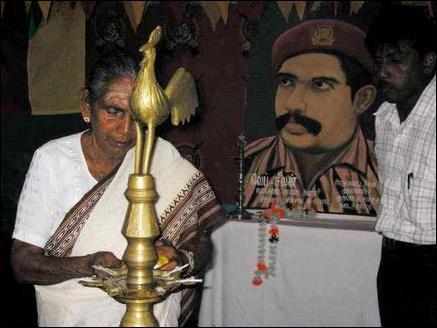
Seelan memorial 2003
“We learnt that there was an LTTE hideout in the Meesalai area. We were trying to get some specific information when we were told that the safe house was in a coconut estate along the Meesalai- Kachchai road,” Sarath Munasinghe told me. The information was picked up by the Kodikamam police and passed on to a senior police officer attached to the combined intelligence unit stationed at the Gurunagar Army Camp. The information was given to Munasinghe by the police officer around 10 a.m. on 15 July. The additional information the senior police officer gave was: the safe house had a toilet under construction.
The information was still vague. It could mean a wild goose chase. Yet Munasinghe decided to try it. “I felt it was extremely important that we prevent an LTTE attack,” Munasinghe said. He walked up to the office of Brigadier Lyle Balthazaar, the commanding officer of the army in Jaffna. He told him though the information was scanty it was worth trying. Balthazaar agreed and provided a 12- member commando unit and a reserve group of six soldiers which included a junior officer.
Munasinghe said he thought that traveling in an army vehicle would rouse suspicion and informants would alert the LTTE group. He planned a hijack of a civilian mini-bus. He sent two soldiers dressed like LTTE fighters to the lonely stretch close to the Clock Tower around noon. They stopped an empty mini bus that came that way, bundled up the driver and cleaner, and drove it to the army camp. The driver and cleaner were locked up in a room.
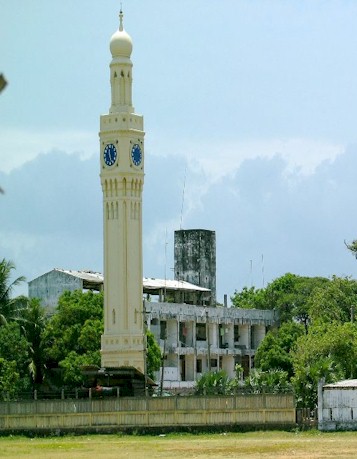
Jaffna Clock Tower today
Then they had a problem in finding a driver. None was available. They had gone on other duties. Munasinghe said he decided to drive. All were in civilian clothes.
“We left Gurunagar camp around 3.30 p.m. The other officer who accompanied us sat behind me ready to take over the steering wheel when needed. We were all silent. Everyone was aware of the seriousness of the mission. I drove fairly fast along Kandy Road, with uniformed soldiers following in an army jeep about a kilometer behind, and turned to Kachchai at Meesalai junction. We saw two pedestrians. We took them into the bus to get their help to locate the coconut estate where a toilet was being constructed. But we failed to locate it,” Munasinghe said. The mini bus drove up to the beach. Munasinghe and the commandos waited there till the soldiers who followed joined them. The time was about 6 p.m. The sun was about to take its evening dip into the sea. The sky was turning bloody. Munasinghe and his men were not in a mood to enjoy nature’s play of colours. They decided to turn back. They stuck to the same arrangement, mini bus in front and the jeep a kilometer behind. “I negotiated a bend close to Kondamoolai and noticed three men on two bicycles just ahead of us,” Munasinghe said. The bicycles were parallel to each other. The one closer to the edge of the road had a pillion rider. Two of the riders wore army-type shirts. The man in the pillion had a gun. I applied the brakes. The bus screeched to a halt close to them. Two of the commandos jumped out firing. I saw the three men fling their bicycles onto the middle of the road and jump over the fence. They ran and took cover behind a thicket. They stopped, turned back and fired at us. They wanted to delay the commandos following them.” Munasinghe recalled. He said the three men started running through the open stretch of rice field that lay before them. “The commandos opened fire again. One of them fell about 100 meters from the thicket where the commandos took position. I saw him falling down. Others continued to run. One of them fell about 200 meters away. I could see the third man trying to drag the fallen one. Then he abandoned the attempt and started running again. He was also hit. But he ran and escaped,” Munasinghe said. Darkness enveloped the area. Munasinghe said he did not permit his men to search the area. He contacted the Gurunagar Army camp over the radio and asked for reinforcements. An army unit under Major Asoka Jayawardhane arrived within an hour. He brought with him some senior police officers.
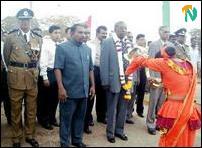
Gov.Gen. of the NorthEast Asoka Jayawardene (with garland) 2004
“None of them were able to identify the dead men. One of them wore an olive green uniform type shirt over a white T-shirt. The police took over the dead bodies and sent them to the Jaffna Hospital mortuary. One of the army’s informants, ‘Xavier,’ identified one of the bodies as that of Seelan. I could not believe it,” Munasinghe said. Balthazaar also refused to believe till Seelan’s mother, who was brought down from Trincomalee, confirmed the identification. The army and the Sri Lankan government celebrated Seelan’s death. The Colombo press, especially the Sinhala media, printed the story with glee. The death of the LTTE’s number two was for them a matter for celebration. Comments like ‘LTTE is finished’ were published. Encouraged by the death of Seelan, army and police intelligence units started their search for Pirapasharan and Sellakili. But they were unaware that Pirapaharan and Seelakili had vowed to take suitable revenge on the army. They were also not aware of the heroic self-sacrifice Seelan had made for the cause of the freedom struggle of the Tamils. The army thought that Seelan was shot dead by the commandos.
No.
Seelan orders his own killing
The three men who flung their bicycles and jumped over the fence when Munasinghe stopped the minibus were Seelan, Ananthan and Aruna. Ananthan and Aruna were pedaling the bicycles. Seelan was seated in the pillion of the bicycle Aruna pedalled. Seelan had his SMG (Sub Machine Gun) on his lap.
Ananthan was the first to be shot. He fell dead about 100 meters from the thicket. Aruna and Seelan ran another 100 meters when Seelan fell. He was not shot as Munasinghe thought. He fell because of the knee injury he had suffered during the Chavakachcheri police station attack, which had not fully healed, had begun to hurt. He tried to get up but could not. Aruna, his childhood friend from Trincomalee, pulled and prodded him.
“Run. Run. We have to run only a little distance,” Aruna pleaded. “I can’t.” The soldiers who were on their bellies were inching in.
“Get up. We have come near the village. If we get to the village we are safe.” Seelan tried to pull himself up. He could not.
“They cannot get me or my SMG,” groaned Seelan with determination. “I will never be caught alive,” he vowed. He had said this several times. He had repeated it like a mantra during the time he was hiding at Nirmala’s house. Nirmala had told Munasinghe that he could not arrest Seelan alive. “Please don’t try that,” she told Munasinghe when he boasted that he would one day or other catch Seelan. Seelan was a daredevil. He was also active. He was intelligent. He was committed to the cause. He was absolutely loyal. For him ‘Thamby’ was not only his leader but also his Guru. He looked straight into Aruna’s eyes and said: They cannot catch me alive. Shoot me and run with my SMG.” To Aruna it was a bombshell. He was shocked. He stood motionless.
Seelan lost his patience. Bullets fired by the crawling commandos grazed them.
“Why are you staring?” Seelan growled. “Shoot and run. Do as I tell you.” Aruna was still undecided. He stood motionless. He was reluctant to kill the LTTE’s Number Two. “They are not going to catch me alive. I am not going to lose to them an SMG,” Seelan groaned and ordered: Now it is an order. Shoot.” Aruna lost his self control. Tear welled in his eyes.
“Shoot… shoot…shoot…” Aruna thrust the barrel on Seelan’s forehead, just above the nose, keeping his eyes away. Then he fired. Seelan collapsed dead and Aruna ran with all his might carrying the SMG with him. He was hit by a bullet. He fell. He got up. He held the wound with one hand and the SMG in the other and ran through villages till he reached Chavakachcheri, He saw a passing car. He stopped it. Pointing the SMG he ordered the driver to get out. The army found the car abandoned at Tirunelveli the next morning. The steering wheel was soaked in blood. Aruna then stopped a motorcyclist and pushed the rider out and rode in it to the LTTE hideout in Neerveli.
Pirapaharan was in that hideout discussing the worrying financial position with Kittu, Sellakili and Pandithar. Aruna ran up to him and told him of Seelan’s death and collapsed. Pirapaharan was shocked. He was silent for a long time. Kittu, recalling that moment said: “It was impossible to make out what his feelings were. But he was thinking hard.” Seelan was very dear to him. He valued him highly. Seelan was aggressive, intelligent, smart and totally loyal. Pirapaharan ordered that Seelan and Ananthan should be suitably honoured.
Posters were put up throughout the northeast saluting Seelan and Ananthan. The posters carried their actual names. Seelan was Charles Anthony. Charles Anthony was from Trincomalee. His background details have been given earlier background in the series. He was promoted posthmously to the rank of Lieutenant. Ananthan’s actual name was Ramanathan Arulnathan. He was from Negombo. He joined the LTTE in January that year. Aruna’s real name was Chellasamy Konesan. He was from Trincomalee and was a childhood friend of Seelan.
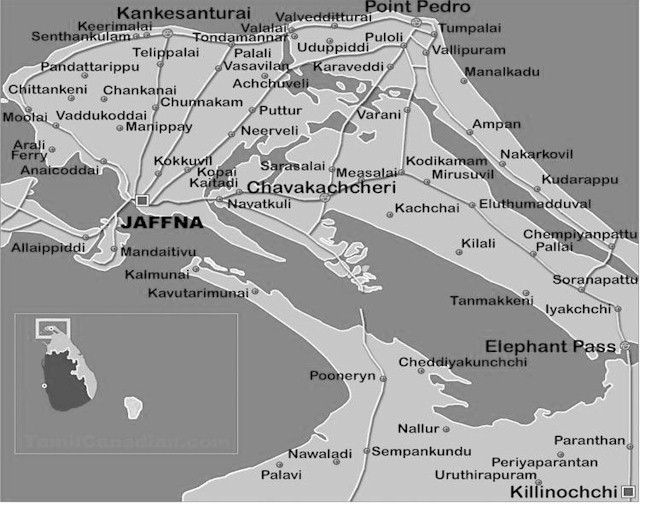
Jaffna Peninsula
The army commenced its investigations that very night. Munasinghe said they picked up a civilian who came to the road on hearing the shots. He showed the army the LTTE hideout. It was a house between Vellampokkady and Kachchai. A person named Sinniah Chandramouleesan of Meesalai East had organized the hideout. Pirapaharan had stayed in that hideout several times.
Investigators found a few documents and a glass capsule. That was the first cyanide capsule that fell into the hands of the army.
The bodies of Seelan and Ananthan were cremated at Tellipalai under police protection.
Munasinghe in his book A Soldier’s Version published the photographs of the bodies of Seelan and Ananthan. He showed me the original of the photographs which he took on 16 July 1983. He said the wound on the forehead and the popping out of the right eye showed that the shot was fired from a very close range. Showing Seelan’s photograph in the book to me he said: “Pirapaharan will buy my book. This is the only photograph of Seelan’s corpse.”
Towards Confrontation
Pirapaharan’s prolonged silence and deep thought was later interpreted by Kittu as indicative of his decision to avenge the death of Seelan.
Anita Pratap, the first reporter who interviewed Pirapaharan and a close observer of his character and reactions, has said in her book Island of Blood, like a wounded Tiger Pirapaharan was ‘most lethal when hurt.’ (Page 71) She said the Sri Lanka army’s euphoria over the death of Seelan provoked Pirapaharan to plan and execute the Thinnaveli ambush. She adds that the ‘vicious attack’ looked like Pirapaharan had taken personal revenge. Pirapaharan does not take the death of his cadres lightly. That is his character. Anita gives two classic instances to prove her assessment. The first was the manner in which he reacted when a griup of his top commanders committed suicide in 1987 at Palaly by swallowing cyanide. She says: ‘In 1987, several top LTTE commanders were arrested by Sri Lankan authorities and were to be taken to Colombo. India tried hard to set them free but Sri Lankan National Security Minister Lalith Athulathmudali refused. Just before they were shifted to Colombo, the LTTE men swallowed cyanide and died. That incident lifted the pin off Pirapaharan’s fury.’
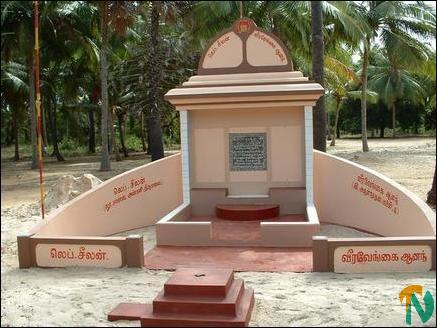
Seelan memorial at Meesalai 2003
The second incident Anita cites happened in November 1994. Lt. Col. Amuthan, who was on his way to Vanni with an important message, was killed in an ambush by the Sri Lankan soldiers. They cut his head and took it away, leaving the body behind. “Pirapaharan was furious,” Anita says. Amuthan’s death took precedence over the peace process. He demanded the immediate return of the head so that he could be given a decent burial. Deputy Defence Minister Anurudha Ratwatte wrote to Pirapaharan informing him that the head had been cremated as it was in an advanced state of decomposition and offered to hand over the ashes. It was after that that Pirapaharan opted to continue the peace process.
Pirapaharan decided to do something big to avenge Seelan’s death. He decided to ambush the army convoy that patrolled Jaffna city and its suburbs every night. The task of planning was given to Sellakili and Kittu. They started watching the convoy, its strength, its route and its routine. They drew a detailed plan and Pirapaharan inspected the location of the ambush and cleared it. He picked 23 July for the attack. Unaware of this, army intelligence was eying for Sellakili. Balthazaar undertook that task. He put his intelligence network on that work. He was partly successful. Information about Sellakili’s movements started coming in. He even got the information that Sellakili was planning an attack in Jaffna on the night of 23 July. He passed the information to Munasinghe and asked him to take out a party and patrol the town after midnight. Munasinghe got ready for that operation with a group of commandos. He instructed the routine night patrol to leave Jaffna city before midnight.
The government also was getting ready to teach the Tamils a proper lesson. Jayewardene’s annoyance against the Tamils rose following the collapse of the All Party Conference on Terrorism on 20 July morning. He clamped censorship on reporting on matters connected to Tamil militancy and army actions. State Ministry secretary Douglas Liyanage was appointed competent authority. On 23 July Parliament extended the emergency rule for another month. The TULF politburo which met on July 23, the opening day of the 2-day Mannar Convention, decided not to talk to the government in future because it had let down the Tamils every time. It also decided to reconsider its decision only if four conditions were met. The conditions were:
1. All parties including the SLFP should attend any discussion.
2. Agenda widened to include the questions of autonomy for the Tamil majority regions and self-determination for the Tamils.
3. Armed forces withdraw from Tamil majority regions.
4. Granting of amnesty for all persons detailed under the PTA.
The government was also was not in a mood to think of the Tamils or their demands. But Jayewardene wanted to keep the international community pleased that he was making efforts to mend fences with the Tamils. So he told Gamini Dissanayake to telephone Jaffna District Development Council chairman Nadarajah and invite him for a meeting, on 21 July. The meeting was held at President’s House. Lalith Athulatmudali was also present. I met Nadarajah that evening at the Sri Lanka Foundation Institute where the Punitham Tiruchelvam memorial lecture was held. Nadarajah told me that he first gave the reasons for his resignation decision. He said he told Jayewardene that the TULF was anxious to cooperate with the government and make the DDC scheme work. The government had failed to devolve power and provide finance to the DDCs. Lalith told him bluntly the government had no intention to devolve power to the DDCs. “It is not the intention of the government. The situation in the country does not permit it. So, don’t talk about devolution of powers,” he said. Nadarajah said he was irritated. He said he turned to Jayewardene and asked him: “Does what Lalith said reflect your position?”
Jayewardene smiled and said Lalith was only conveying his (Jayewardene’s) thinking and added: “Don’t take hasty decisions. Let things simmer for the present. Later we will consider strengthening the DDCs.” Nadarajah said he retorted hotly. “Till then what do you expect us to do? Sit in our desks and drive flies?” Jayewardene tried to calm Nadarajah down. He said his intention was to strengthen the DDCs. Things are a little hot now. Let it cool down.
Lalith intervened and said that they understood the predicament of the TULF. “Your problem is that you must show the people that they are deriving some bemefit out of the DDC scheme. We will provide you funds to build a stadium, markets, school buildings and the like. That will keep you busy and people satisfied,” Lalith said. Nadarajah said he declined the offer. He told them that they were interested in laying the foundation for a permanent solution rather than such small mercies and crumbs.
Jayewardene told Nadarajah that they could discuss those matters at the next meeting and adjourned the meeting.
Nadarajah’s summing up of the meeting was: This man talked nicely and bought time. Jayewardene’s strategy was to make Nadarajah defer his resignation. In that he had succeeded. I did not write that story for the Daily News. I did not want to put my editor into a predicament. Instead he printed the story Lalith gave him: Nadarajah had deferred his resignation. Further discussions to follow.
Jayewardene wanted to buy time. He and his men had planned a different course of action. Cyril Mathew’s trade union – the Jathika Seva Sangamaya (JSS) – had begun collecting the address of Tamils of all levels and storm troopers were getting ready. I was a member of the JSS Lake House branch. They treated me with some respect. Three or four days before the riots erupted a committee member wishpered to me, ‘something was going to happen.’ Then with great reluctance he said: “They are compiling a list of Tamil journalists.” I was able to ‘smell’ something strange in the air. I could also ‘feel’ the anti- Tamil atmosphere building up. Lanka Guardian editor Mervin de Silva too had heard that talk. He referred to it much later, in his column ‘Men & Matters ‘which appeared in the Sunday Island of 2 February 1992. He wrote:
At least a week before that savage eruption, there was talk of ‘something about to happen’ … something nasty, of a ‘lesson’to be taught.’
On July 23, around midnight, LTTE men led by Prabakaran waited near Tirunelveli junction for the army patrol “Four-Four Bravo”. All the top men of the LTTE at that time, Kittu, Iyer, Victor, Pulendran, Chellakili, Santhosam and Appiah, waited anxiously on both sides of the road. They had planned a landmine explosion and an ambush.
Pirapaharan was not aware at that time that his attack on the army was going to change the entire course of Sri Lankan history. Jayewardene, who unleashed his shock troopers the following night, was also unaware that his action was going to destroy the very foundation of Sri Lanka’s social structure. The fatal 24 hours, midnight of 23 July to midnight of 24 July 1983, opened a new era with which Sri Lanka is still wrestling.
Next: Volume 2: LTTE – Consolidation of Power
Introduction
To be published April 21